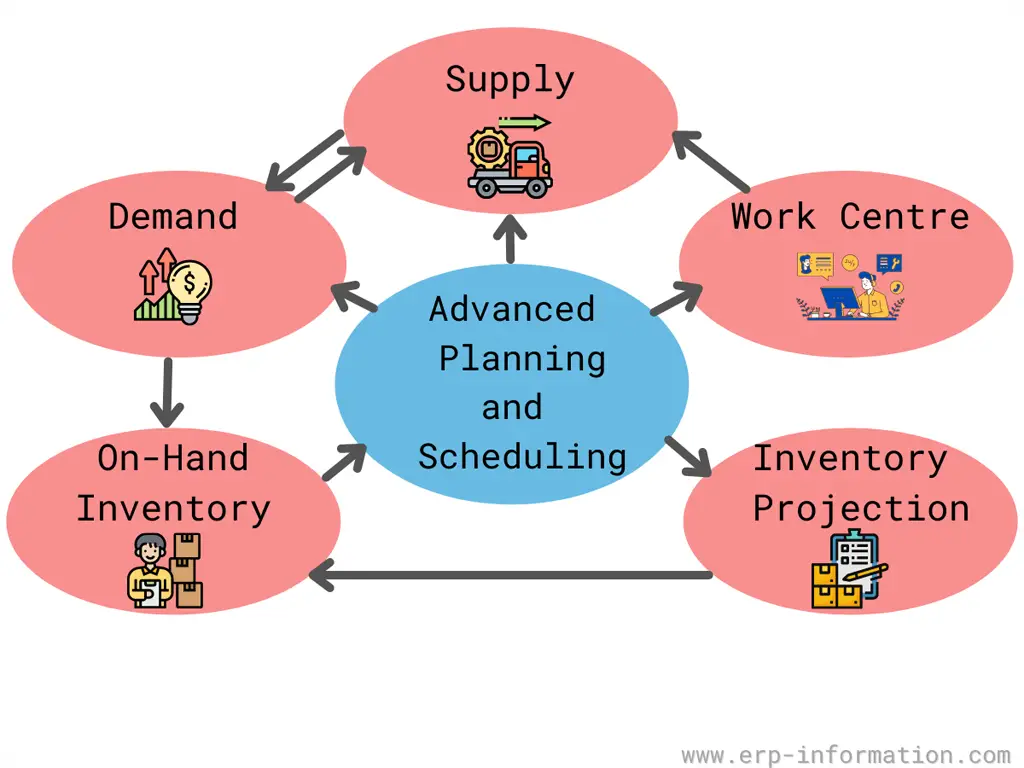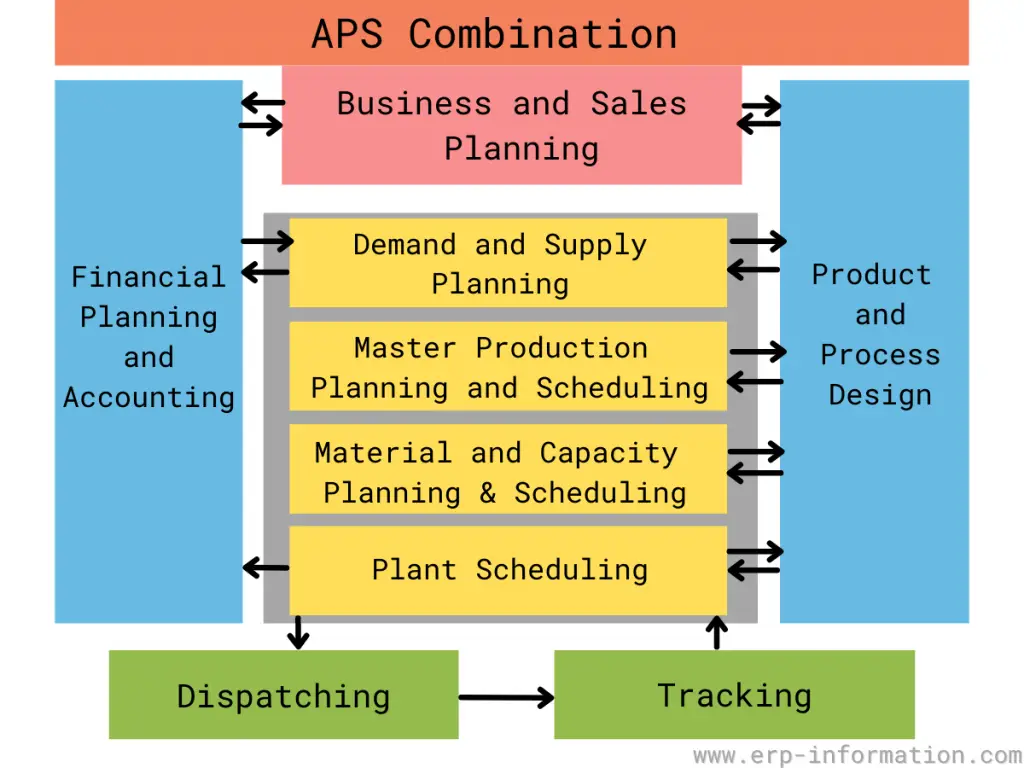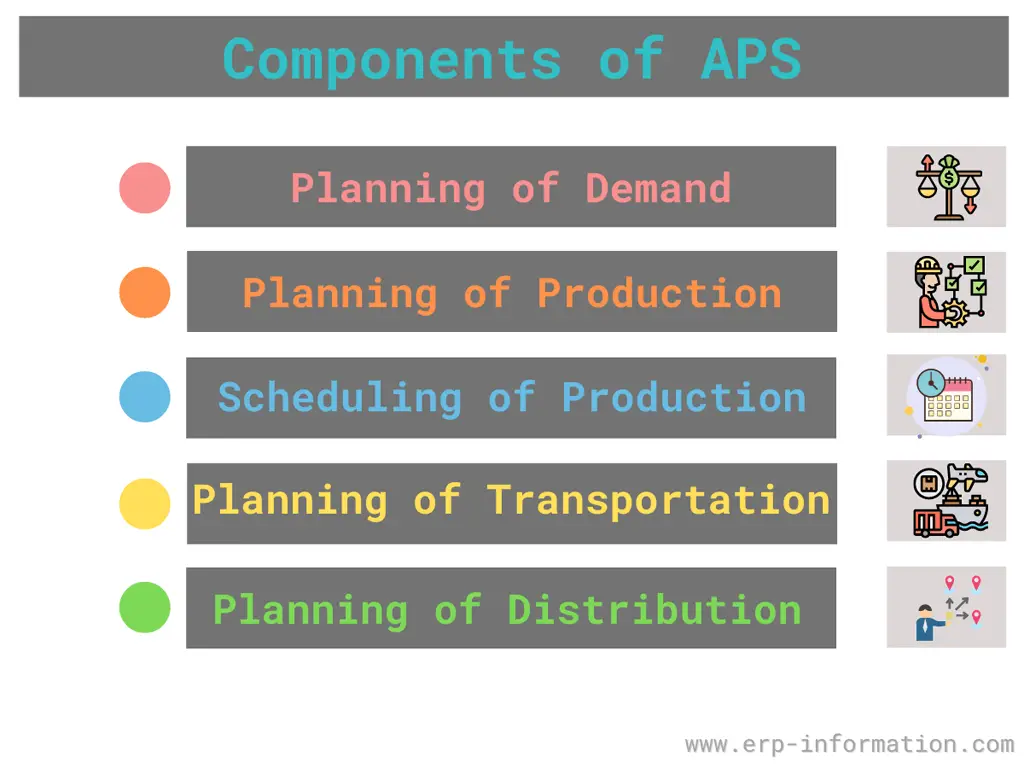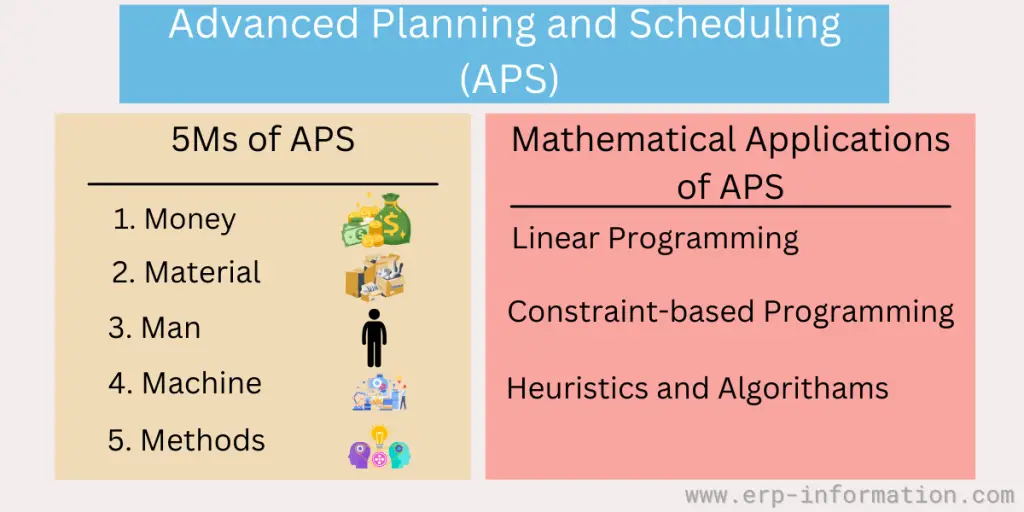APS is a comprehensive planning and scheduling solution that helps organizations optimize resources and minimize costs.
It enables planners to create detailed production schedules, allocate resources, and track progress against targets. It can also help identify potential bottlenecks and manage risks.
In short, it allows organizations to plan and control their operations more effectively.
This post will look at APS, its components, the five M’s of it, its mathematical applications, and some of its key benefits.
What is Advanced Planning and Scheduling?
Advanced Planning and Scheduling is a system that helps track a manufacturing unit’s resources for smooth production.
It helps optimally allocate raw materials and production capacity to meet the demand.
It considers all the major production factors, including people, machines, inventory, and costs.
APS ensures an appropriate balance between raw materials and the business’s production processes. Therefore, it is an essential division of supply chain management.
How does Advanced Planning and Scheduling Enhance Business?
- It generates realistic reports to help analyze the unit’s production capacity and plan the next course of action accordingly.
- It helps understand the production and list out the required raw materials to ensure smooth working production of the system.
- It helps streamline the inventory system of the business and makes it more efficient.
- It assists in improving the time management system by analyzing and interpreting the time consumed for each process.
- It designs a real-time data system that captures the time and resources required. Thus, it improves the delivery time and delights the customers with prompt services.
- It helps to identify the exact resources that are required for production.
- It helps the manufacturer determine what to make, how much to make, and when and where to make it.
Advanced planning and scheduling help supervise some aspects of the production process. Those are
- Enhancement of advanced schedule
- Controlling advanced materials
- Make-to-order planning
- Make-to-stock planning
- Visualization of assemble process
- Advanced constrain modeling
- Planning of Bill of Materials (BOM) level
- Master production schedule creation
- Visualization of interactive schedule
Components of Advanced Planning and Scheduling
Planning of demand
Demand planning helps to generate an accurate forecast by considering the previous sales data and importing consumer forecasts.
Demand planning allows you to manufacture the exact quantity of products with reduced inventory cost and waste.
Planning of production
Production planning is a process. This process gives a clear picture of available raw materials, general labor, and tools to make products of the specified quantity.
The production plan allows an organization to carry out various activities without interruption.
Scheduling of production
The production schedule is also a process that helps to handle, arrange and optimize the work in the production process. It helps to reduce inventory and load on laborers.
Planning of distribution
This process allows workers to set inventory parameters like on-hand inventory at the beginning and the safety stock requirements for a while to reach order fulfillment.
Planning of transportation
This process helps identify the goals, future policies, and investments required to transport people and goods to destinations.
Five Ms of APS
- Money
- Material
- Man
- Machine
- Methods
Money
The most important of the five Ms is money. Money allows a business to purchase the resources it needs to operate.
Without money, a company cannot buy materials, hire workers, or purchase equipment.
Material
Material is anything that a business uses to produce a product or service. This includes raw materials like wood, metals, other natural resources, and finished goods like clothing, food, and electronics.
For a business to be successful, it must have suitable materials in the right quantities at the right time.
Man
The man component of an APS refers to the people who work in a business. Whether it is the CEO, accountants, sales representatives, or customer service employees, companies rely on their employees’ skills and expertise to succeed.
Without people who can manage resources effectively and deliver high-quality products and services to customers, a business would not be able to thrive in today’s competitive marketplace.
Machine
Machines are another vital component of APS. Machines automate many business processes, making it easier and more efficient for employees to do their jobs.
For example, machines can assemble products, optimize supply chains, and process customer orders.
Without machines in modern businesses, production would be much slower and less accurate than today.
Methods
Finally, businesses must have effective methods in place for managing their resources. This includes having systems and processes to track inventory levels, maintain quality control, and ensure that products and services are delivered on time.
Without these methods, businesses would quickly become chaotic and unable to function correctly. In APS, processes are critical for ensuring that a company can achieve its goals and objectives.
Mathematical Applications used in Advanced Planning and Scheduling
Linear programming
LP is a method to achieve the best outcome (maximum profit or lowest cost) in a mathematical model whose requirements are represented by linear relationships.
Linear programming is a particular case of mathematical programming (also known as mathematical optimization).
Constraint-based programming
CBP is a paradigm for solving problems in which some constraints (relationships) must be satisfied.
In CBP, the programmer specifies a set of constraints and the relationships between them, and the system automatically derives a solution that satisfies all the constraints.
Heuristics and algorithms
These are methods for finding solutions to problems. Heuristics are general guidelines that can help solve a problem, while algorithms are specific sets of steps that consistently produce a correct solution.
APS can offer solutions to various issues that a company might face with time and boost the customer service system.
With the help of APS, a company can formulate accurate strategies by clearly defining the market demand and how the production can gear up to capture a more significant share of the market with adequate supplies.
It will help the business make crucial decisions about business expansion by analyzing its production capacity and sales forecasting.
It can help the company study all aspects of the business, from manufacturing to distribution, and then schedule production accordingly.
Advanced Planning and Scheduling Software Systems
Various APS software systems are available both in commercial and open-source variations.
Some of the open-source APS software systems available for the supply chain are
Most modern cloud ERP solutions are either available with APS functionalities or integrated with external APS systems.
What are the software systems available for Advanced Planning and Scheduling?
Advanced planning and scheduling software systems are available from various vendors, including Oracle, IBM, and Microsoft. These systems allow businesses to optimize their production schedules and resources to improve efficiency and achieve strategic goals.
A few popular software systems available for Advanced Planning and Scheduling are PlanningForce, Cybertech, Dynasys, Ortames, Orchestrate, Optessa, and Delfoi.
Uses of Advanced Planning and Scheduling Software
APS will easily merge with the ERP system. The software helps the people in the planning team save their time during the updation of production schedules, inventory plans, and priorities.
- It generates enhanced scheduling that balances delivery performance and efficiency of production.
- It helps to maximize resource usage to improve the company’s revenue.
- Accompany the demand and supply to decrease the inventories.
- It allows you to visualize the capacity available throughout the organization.
- Validate the scenario-based data for decision-making.
- It helps upgrade the production process to the next level with increased efficiency.
Benefits of APS
Improved Synchronization: APS helps align manufacturing processes more effectively. This means that different parts of the production process work together smoothly, reducing bottlenecks and delays.
Enhanced Visibility: APS provides a clearer view of the entire production process. This visibility allows businesses to track progress, manage resources efficiently, and make informed decisions.
Increased Utilization: With better scheduling, resources like machinery and labor are used more efficiently. This not only maximizes their use but also reduces downtime.
On-Time Delivery: APS helps businesses meet delivery deadlines, ensuring products are delivered when promised. This enhances customer satisfaction and trust.
Inventory Reduction: By optimizing production schedules, APS can minimize the need for excess inventory. This leads to cost savings and reduced waste.
Advanced Math: APS relies on complex mathematical algorithms to calculate achievable production schedules. This analytical capability allows manufacturers to make precise plans, considering multiple constraints and business rules.
What-If Scenarios: Planners can create and evaluate “what-if” scenarios. This flexibility enables businesses to explore various options to achieve the best results, adapt to changes, and mitigate risks.
Full Visibility and Control: APS offers a comprehensive view of the manufacturing process, empowering businesses to maintain control over operations.
Inventory Reduction: By optimizing production schedules, APS can minimize the need for excess inventory. This leads to cost savings and reduced waste.
Better Customer Service: Timely delivery and reliability in meeting customer orders improve overall customer service and satisfaction.
Higher Margins: By optimizing operations and reducing waste, APS can contribute to increased profitability and higher profit margins for businesses.
Conclusion
APS is a methodology that helps organizations remain on schedule for their projects. As the name implies, it provides advanced planning and scheduling tasks to ensure they are completed on time.
It allows companies to plan more effectively by identifying all activities upfront, so there are no surprises during execution.
It also ensures that everything gets done by its due date, decreasing project risks significantly because you’ve already planned for any potential delays or bottlenecks before they happen.
This lowers your risk exposure while increasing efficiencies on-schedule delivery times increase customer satisfaction with better quality work products!




